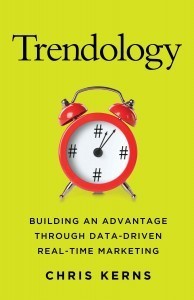The New Book that Plays Moneyball with Real-Time Marketing

Over the past few years, there’s been a lot of talk about real-time marketing—the practice where brands jump on social trends to join a popular conversation. Some have said it’s the next big thing. Some have said it’s a flash-in-the-pan that will be gone before we know it. Many have said that real-time success only works for one brand per big event, and that RTM is a winner-take-all game. A lottery ticket. A lot of talk, and a lot of opinion.
But how do you, as a marketer, decide if this is a strategy that is good for your business and your brand? How do agencies answer the growing question from clients asking “Shouldn’t we be doing RTM?”
About a year ago, I began researching real-time marketing. I wasn’t necessarily interested in seeing if certain social posts were funny or on-brand or clever—I wanted to find out if RTM worked.
It’s Time to Bring Data to the RTM Discussion
The best way to figure out if real-time drives results is to use good, old fashioned data. To get a good sample of RTM performance, I pulled the past few years of Twitter data for over 100 of the top brands in the world. How does the audience respond when brands go outside of their campaigns and join conversations on relevant topics? Do certain types of real-time engagement work better than others?
The result of this research is my new book Trendology, which is now available in bookstores everywhere. It’s a movement to change the discussion and opinions around real-time marketing using analytics and a data-driven approach.
As I dove into the vast amounts of social data from the world’s top brands, I was surprised at what the data was showing. In most cases, when brands are doing real-time marketing correctly, the data shows that the audience absolutely loves it when brands speak to them about relevant topics. And not just for big events, but for smaller events and everyday trends as well. Who knew?
Relevant Topics Drive Follower Engagement
Here’s a quick example—the announcement of the iPhone 6 and Apple Watch just a few weeks ago. During the announcement, I saw 15 brands create real-time content around the event, including this Tweet from Chili’s:
If we believe what we’ve heard from the critics, RTM will work for maybe 1 of those 15 brands, and the rest will look silly trying to jump on a conversation where they’re “unwanted.” But when we look at the data, we see something very, very different happening.
Of the 15 brands that jumped in on the iPhone conversation, 13 of them saw increased engagement (both in retweets and favorites) vs. their own historical engagement rates. THIRTEEN! And not only that, the increases in engagement and sharing were ridiculously big. The average increase in retweets was more than +1,300%, the increase in favorites came in at around +950%. Sure, there were a few brands that did better than others, but 87% of brands saw a positive result with big numbers to back up their efforts. I’m seeing this same pattern of success across a diverse set of events and topics, from big events (like the Oscars, Grammys, and Super Bowl) to everyday trending topics.
Suddenly, RTM doesn’t look like a lottery ticket any more, does it?
RTM is Different and Strange and It Works
Real-time marketing isn’t what we’re used to seeing or building as marketers, and the resulting quick-turn creative results can be easy to poke fun at. The practice is new and it’s different and yes, it’s kind of weird. This leads many marketers to label real-time marketing as a gimmick, but the data shows that’s not what’s really happening here.
Social networks are enabling a new method of communication with our audience— conversations—and relevance is one of the most important factors when brands are looking to join a discussion. To take advantage of this new reality, marketers need to build out a data-driven process and team to balance the risk and reward of acting in the moment. With a good framework, RTM can work for any business.
As you will see in Trendology, the data shows that social marketing is evolving, and audience is welcoming this shift with enthusiasm. The main question is: are you ready for the move to real-time?
[image error]






